Abstract
As energy efficiency measures have reduced the operational carbon footprint of buildings, the significance of embodied carbon has increased. Efforts by all construction players, including material and component manufacturers, are needed to avoid burdens shifting towards embodied impacts. Environmental Product Declarations (EPDs) can represent useful instruments to push the decarbonization of construction materials. This study examines EPDs to assess the embodied GWP of insulation materials, bricks, concrete, cement, steel, and natural stones. The variance structure of the GWP was studied for each material, the main variation parameters were detected, and statistically significant categories were identified. For each category reference values were calculated (i.e., mean or median values, lower and upper interquartile ranges, and box plot whiskers) which can be useful for manufacturers to reduce the impact of their products, for EPD verifiers to detect outliers, and for designers to determine safety coefficients for using EPD data in the early design stage. Consolidated results were achieved for materials produced through standardized processes whose GWP variability was mainly structured around universal physical properties or production techniques. More localized or artisanal products demonstrate higher decarbonization potential but require further segmentation and additional GWP data to establish more robust reduction benchmarks.
1. Introduction
The most recent United Nations report dedicated to greenhouse gas emissions from the building and construction sector [1] highlights that, in 2022, the energy demand from buildings (for heating, cooling, hot water, lighting, cooking, and other uses) accounted for approximately 30% of global energy demand. If the embodied energy used to produce building materials is included, this percentage rises to 34%.
In the last decade, there has been an average annual growth of about 1% in energy demand from buildings. The share of electricity usage in building energy consumption has increased from 30% in 2010 to 35% in 2022, driven in part by the spread of renewable energy production systems (especially photovoltaic panels). Despite this, the use of fossil fuels in buildings has increased over the last ten years at an average rate of 0.5% per year, primarily due to developing countries. To meet the enormous demand for buildings in these countries, the United Nations [2] estimates that construction materials will dominate resource consumption; emissions linked to the production of construction materials will increase from 3.5 to 4.6 Gt CO2eq per year by 2060.
To address the challenges of climate change, the building sector has primarily focused on reducing emissions from energy consumption during the operational phase of buildings [3]. Even at the regulatory level, various energy standards introduced over the years in industrialized countries have aimed to reduce consumption and related emissions during building operation by minimizing heat losses, improving system efficiency, and finally integrating renewable energy production systems [4]. And it is precisely because buildings are becoming increasingly energy-efficient and electricity production (European national mixes) has significantly decarbonized that the operational energy and related carbon dioxide emissions of new buildings have decreased significantly [5].
The run-up toward low-energy buildings, however, is shifting the environmental impact of the construction sector from operational energy consumption to the embodied components [6]. For instance, Life Cycle Assessment (LCA) applications in nearly Zero Energy Buildings showed a significant trade-off regarding embodied impacts that, when the operational energy consumption is reduced to a very low value, can account for a very significant percentage of the total life cycle environmental load [7,8,9,10]. To provide some reference values, while in standard buildings the average share of the embodied greenhouse gas emissions represents about 20–25% of the total greenhouse gas emissions over the entire life cycle, this figure rises to 45–50% for highly energy efficient buildings and exceeds 90% in the extreme cases of buildings with cutting-edge, experimental performance [11].
A reduction in embodied impacts calls for the adoption of new design paradigms, including the incorporation of renewable energy into construction materials and the shift from linear to circular models [12]. This is particularly critical given that the production of certain building materials, such as bricks and cement, is highly energy intensive and, when reliant on fossil fuel-based production chains, significantly contributes to greenhouse gas emissions. Low-impact materials play a pivotal role in containing the shifting of impacts onto embodied components and reducing the impacts generated by the building industry. At the same time, minimizing waste and recovering valuable substances are important strategies to reduce the use of virgin resources and manage end-of-life impacts. This is particularly relevant for construction and demolition waste, as its treatment and disposal can be complex and expensive [13].
To facilitate the decarbonization of construction materials, the European guidelines related to Green Public Procurement (EU directives 2014/23/EU, 2014/24/EU, and 2014/25/EU) are strengthening the adoption of Environmental Product Declarations (EPDs). EPDs are instruments developed to enable the comparison of the environmental impacts of construction materials, products, and components that share the same functional purpose. The EPDs published in Europe adhere to the European Standard EN 15804 to guarantee that the information is presented according to standardized LCA methodologies, employing uniform environmental indicators to disclose environmental impacts.
We are undergoing a critical transition in the building and construction sector, which demands substantial and collaborative efforts by all stakeholders, including material and component manufacturers, designers, construction companies, real estate developers, and end users. For an effective decarbonization of the sector, the LCA approach should be more widely adopted, both through its application at the building level and the use of EPDs to quantify the embodied carbon of building components and materials.
This work aims at reviewing the current state of the art regarding the proliferation of EPDs for building materials and components, with a focus on discussing their role in the decarbonization of the construction industry.
2. Materials and Methods
2.1. Materials
This study reviews EPD data about the “cradle to gate” fossil Global Warming Potential (GWP) of construction materials and components. The modules covered are thus A1–A3: raw material supply (A1), transport to the production site (A2), and manufacturing process (A3). The certifications considered are all realized in compliance with the EN 15804 standard. GWP was selected due to the robustness and consolidation of this indicator [14,15] and to the possibility of considering EPDs based on different versions of the EN 15804 standard (e.g., EN 15804+A1-2013 [16] or EN 15804+A2-2019 [17]). In fact, both amendments of EN 15804 provide substantially equivalent results [18], making the selection of a specific version unnecessary and increasing the number of available EPDs.
EPDs were searched by consulting the online databases of different program operators (POs). In particular, the following sources were considered:
- International EPD Systems (INT)—a global program for EPDs managed by Environmental Product Declaration International AB.
- The IBU program (IBU)—a certification and verification process for EPDs managed by the Institut Bauen und Umwelt e.V., a German organization.
- EPD-Norge (NOR)—a Norwegian platform for EPDs.
- The INIES program (INI)—a French database that includes EN 15804 certifications voluntarily submitted by manufacturers and trade associations.
- The BRE EPD program (BRE)—an EPD certification system managed by Building Research Establishment (BRE) in the UK.
- EPD Danmark (DAN)—a national platform for EPDs in Denmark managed by Miljømærkning Danmark.
- EPD Italy (ITA)—a national program for EPDs in Italy managed by the organization Federazione Anima.
- EPD Ireland (IRE)—a national platform for EPDs in Ireland.
- Stichting MRPI (MRPI)—a Dutch initiative aimed at providing reliable EPDs in the Netherlands; it is managed by the Milieu Centraal organization.
- Bau-EPD (BAU)—an Austrian platform that provides EPDs for the construction sector.
- DAPconstrucción (DAPc)—the “Declaración Ambiental de Producto para la Construcción” is a Spanish program for EPDs specifically related to the construction sector.
- Asociación Española de Normalización database (AEN)—another Spanish initiative.
- DAPhabitat (DAPh)—a Portuguese national initiative for the management of EPDs specifically tailored for the construction and building sector; it is managed by the Associação para a Sustentabilidade da Construção.
- EPD Hub (HUB)—a global platform that provides EPDs for various industries, including construction, manufacturing, and other sectors.
- ZAG EPD (ZAG)—refers to the platform managed by the Zagreb Institute of Construction, which is a Croatian organization that manages the issuance of EPDs for products in the construction industry.
- RTS EPD (RTS)—a Finnish EPD program primarily focused on the construction and building materials sector.
- Technical and Test Institute for Construction Prague (TZUS)—a Czech company operating as a certification and testing body for construction materials and related products.
- ITB EPD Program (ITB)—voluntary program for construction products in Poland.
- Kiwa EPDs (KIW)—a database developed and verified by Kiwa, an international certification body.
- SCS Global Services (SCS)—an international organization active in environmental certification and sustainability verification.
- Tata Steel EPDs (TAT)—an international company developing EPDs for some of its products.
- ASTM International (ASTM)—an American organization developing voluntary technical international standards for a wide range of materials.
- UL Solution (UL)—an American independent company that certificates environmental product declaration for different type of products.
- EPD Australasia (AUS)—an independent organization active in Australia and New Zealand that provides EPDs for the businesses sector.
- Belgian EPD Program (B-EPD)—voluntary program for construction products in Belgium.
EPDs from the ECO Platform [19] were prioritized in this study: the platform serves as an umbrella for various EPD programs, ensuring consistent quality through verification criteria, regular audits, harmonization, mutual recognition, and dispute resolution.
The materials considered are thermal insulating materials (e.g., EPS, stone wool), bricks, cement, concrete, stones, structural steel (i.e., profiles and rebars), windows, wood, photovoltaic panels, and heat pumps.
2.1.1. Insulation Materials
The dataset created consisted of 97 EPDs certifying expanded polystyrene (EPS) and 41 for stone wool (SW) panels. These materials are currently among the market leaders in terms of mineral- and fossil-based insulating panels [20].
To compare different insulation materials, we used, as a functional unit, 1 m2 of an insulation panel with a thickness that gives a thermal resistance R = 1 m2K/W, and with a design life span of 50 years. This choice is increasingly recommended in the literature [21,22,23,24] because it indirectly makes it possible to consider quite uniform operational thermal performances as well as eventual substitution requirements for different insulation materials. In this way, modules B1-B4 are indirectly accounted for in a “cradle to gate” evaluation. Even with a variable reference value for the thermal resistance of the panel, more EPDs are adopting this type of functional unit. However, other functional units, such as kilograms or cubic meters of material, are still in use, thus making the declaration of the density and of the thermal conductivity of the panel necessary for conversion purposes.
The information collected consists of the fossil GWP (modules A1–A3), the typology of the panel (e.g., EPS, SW, etc.), the density of the material, the energy mix used in the production process, the percentage of secondary material in the total mass of the panel, the production country, the PO and the background LCA database used. The energy mix was considered “fossil based” if the total use of non-renewable primary energy resources, including secondary fuels, exceeded 90% of the total embodied energy; a “green” energy mix was instead characterized by the use of renewable primary energy resources, including secondary fuels, exceeding 50%. Table 1 describes the sample considered.

Table 1.
Overview of the dataset considered for insulation materials.
2.1.2. Bricks
The dataset consists of 60 EPDs prepared by European POs in accordance with EN 15804+A1 or EN 15804+A2. The FU chosen is 1 ton. The information collected consists of the fossil GWP (modules A1–A3), the typology of the product (e.g., full bricks, hollow bricks, adobe bricks), its density, the energy mix used in the production process, the PO, and the production country. Only a small number of the EPDs examined reported the average compression resistance or thermal conductivity of the material, primarily for hollow blocks. Because of the incompleteness of this kind of information, these parameters were not considered.
Of the 60 EPDs in the dataset, 12 are for hollow bricks, 48 are for full clay bricks, and 1 is for an adobe brick (see Table 2). The production sites are unequally distributed in 18 countries.

Table 2.
Overview of the dataset considered for bricks.
2.1.3. Concrete
The dataset considered in the following assessment is composed of 79 data points of embodied GWP (modules A1–A3) for ready-mixed concretes with different mechanical resistances reported in EPDs. The main features of the sample are reported in Table 3. The information extracted from the EPDs consists of: PO, production country, production company, density, background LCA database (Ecoinvent, GaBi (Zurich, Switzerland)), and resistance class (based on EN 1992-1-1:2004, Eurocode 2 [25]). Almost all of the EPDs reviewed used m3 as their functional unit.

Table 3.
Overview of the dataset considered for ready-mixed concretes.
2.1.4. Cement
The analysis of cement EPDs yielded sixty-four values for embodied GWP. Additionally, the information collected regarded the cement type (based on EN 197-1 [26]), the production country, the producer, the PO, the compression strength class (based on EN 197-1 [26]), the clinker content, the background database used for the LCA (e.g., GaBi, Ecoinvent or both (Zurich, Switzerland)), and the energy mix declared for the production processes (e.g., PERT, PENRT, RSF, NRSF). The cements were produced in thirteen European countries by twenty different companies. The functional unit adopted, as reported by all the EPDs consulted, is equal to 1 ton. Table 4 describes the main characteristics of the sample.

Table 4.
Overview of the dataset considered for cement products.
2.1.5. Natural Stones
An online search for EPDs of natural stones yielded 58 certifications. Fifty-seven were product-specific, while one was a generic certification representing the average production of ten European companies. The specific products, which are certified by nine European POs, are produced in Europe by 23 companies. All the natural stone products considered are locally manufactured with manufacturing sites which are located close to the quarry where the raw material is extracted.
Most of the certifications found adopted 1 ton as their FU; 1 m3 or 1 m2 of paved surface is seldom adopted in EPDs of slabs. However, it was possible to convert all other FUs into tons using the density of the material. For slabs, all other FUs could be converted to 1 m2 using thickness.
The information collected regarded the embodied fossil GWP, stone typology (i.e., granite, marble, limestone, quartzite, sandstone, porphyry), final product typology (i.e., quarry blocks, walling blocks, setts, and slabs with or without surface finishing), density, thickness (in the case of slabs), production country, producer, PO, LCA background database (i.e., Ecoinvent, GaBi (Zurich, Switzerland)), electricity mix considered in the LCA modeling, and mechanical performance (i.e., compression and flexural resistance). The information related to mechanical properties was quite uncommon in the EPDs consulted, not allowing for any correlation with the environmental profile of the material.
An overview of the EPD reviewed for natural stones is provided in Table 5.

Table 5.
Overview of the dataset considered for natural stone products.
2.1.6. Structural Steel
The dataset considered consists of 59 EPDs based on EN 15804 [16,17] are for low-alloyed structural steel sections, and 20 are related to reinforcing bars. The EPDs were randomly searched online.
The information collected consists of the fossil GWP attributable to modules A1–A3, the typology of the product (i.e., structural profiles, steel reinforcing bars), the manufacturing process (e.g., electric arc furnace—EAF, blast oxygen furnace—BOF, or a combination of both), the recycled scrap content, the mechanical properties, the energy mix used in the production process (e.g., PERT, PENRT, RSF, NRSR, certified green electricity, national mix, residual national mix, local mix), the emission factor for electricity consumption, the PO, the producer, the production country, the background database used for the LCA (e.g., Ecoinvent or GaBi (Zurich, Switzerland)), the benefits linked to scrap recycling (module D). In relation to the manufacturing process, structural steel is currently produced using two main production methods: blast oxygen furnace (BOF) and electric arc furnace (EAF). BOF continues to dominate global steel production while EAF is gradually acquiring market positions, particularly in North America, the EU27, and Middle Eastern countries [27]. According to the European Steel Technology Platform, EAF accounts for nearly 46% of total steel production in Europe. The FU considered was 1 metric ton, consistent with quite all consulted EPDs.
For all the steel sections considered, the EPDs reported a Young modulus of 210,000 MPa, a Shear modulus of 8100 MPa, and a density of 7850 kg/m3. In relation to reinforcing bars, the steel mechanical grade was B450 or B500.
Table 6 describes the dataset. It basically covers the steel production of 25 fabrication companies with manufacturing sites located in 17 European countries including the UK, Turkey, and Switzerland.

Table 6.
Overview of the dataset considered for structural steel products.
2.1.7. Windows
The analysis of EPDs reveals a diverse range of POs actively engaged in global certification initiatives within the window systems market. Figure 1a presents the dataset created for this study: 70 valid EPDs in 2024 were derived from POs’ websites or archives. The assessment covers the EPDs of the window systems, excluding patio doors. A total of 178 values of GWP were derived from the EPDs collected.
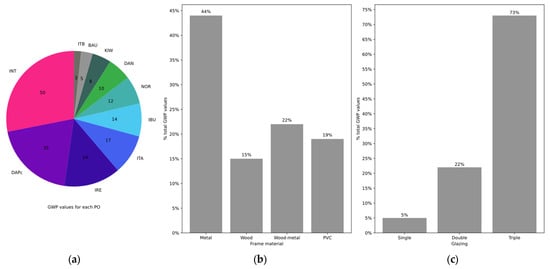
Figure 1.
Overview of the dataset considered for windows: (a) per PO, (b) based on the frame material, (c) based on the glazing type.
The International EPD system leads the ranking, listing 50 EPDs, while DAPc and IRE follow with 35 and 24 EPDs, respectively. Small contributors in the windows scene are BAU and ITB, which contributed less than 5 EPDs each. This distribution provides evidence of the gap in the involvement and capacity of PO due to the factors related to regional market maturity and regulatory environments.
Following the classification already provided by works in the literature [28,29], Figure 1b,c display, respectively, the EPD values based on the type of material used for the frame (metals, wood, wood–metal mixtures, or PVC) and the glazing configuration (single-, double-, or triple-pane).
Metals dominate the distribution of frame materials with almost half of the total share. This is not surprising, as the trend probably just reflects the general use of metallic materials in window frames. Wood and combined wood–metal frames represent 37% of the distribution.
Interestingly, the data reveal a clear upward trend in certifying triple-glazed windows by the building industry. This might be justified by the substantial benefits related to energy efficiency and comfort of living linked to triple-glazed windows [30]. These windows have superior thermal and acoustic insulation compared to either double- or single-glazed windows, which is vital for decreasing energy consumption and increasing the standard of living.
The functional unit used in this study was the square meter of windowing, which allowed a common base for comparison among the various window systems being analyzed.
2.1.8. Wood
Wood has experienced a surge in popularity as a construction material in recent times due to its lightweight and structural efficiency, especially in self-weight resistant structures [31], and its potential to reduce greenhouse gas emissions compared to traditional building materials like concrete and steel [32]. Starting from the findings of previous studies [33,34], this work describes the EPDs relating to a review of 101 structural wood products embracing cross-laminated timber (CLT), glued laminated timber (Glulam), laminated veneer lumber (LVL), and sawn timber.
In addition to the typology of the product, the data extracted from the EPDs regarded the density of the material, the PO, the background database used for LCA modeling, the embodied GWP (modules A1-A3), the biogenic carbon, and the EoL GWP (modules C3–C4) process (e.g., PERM, PERT, PENRE, PENRT, RSF, NRSR). When biogenic carbon was not declared, it was determined following the methodology described by EN 16449 [35].
To enable comparison, all impact results from the EPDs were normalized considering as FU a kilogram of product or its volumetric unit (conversions were possible through density normalization). Table 7 shows the distribution of EPDs across the PO.

Table 7.
Overview of the dataset considered for wood products.
The PO data show big disparities in the distribution of EPDs. The highest number of declarations is made by INT, BU, and NOR, totaling around 60%. Timber and glulam have the highest number of EPD representatives, while LVL remains significantly under-documented. This concentration may create bias in the global representativeness. MRPI, RTS, and UL Environment have a limited impact with only a few EPDs.
2.1.9. Photovoltaic Panels
The database considered contained 24 EPDs with 31 types of photovoltaic panels distributed among three POs: INT (25), DAN (4), and NOR (2). This distribution highlights that the diversity among analyzed programs is low, which may affect the general variability of the data. All analyzed panels are of the same type: monocrystalline silicon. The panels analyzed have the ability to harness reflected light, i.e., light that bounces off surfaces and reaches the rear of the solar module; 30% of the panels analyzed are indeed bifacial.
In this study, the square meter was the functional unit, enabling comparisons of GWP with respect to the surface area of a panel, as opposed to its peak power per square meter.
2.1.10. Heat Pumps
Only a few EPDs concerning heat pumps have been publicly registered so far and only 7 EPDs were scrutinized.
In addition to the GWP (modules A1–A3), the information reported in Table 8 was derived from the EPDs. The functional units given in the examined EPDs relate to the ability of the products to supply heating or cooling during the declared life span.

Table 8.
Review of EPDs found for heat pumps.
2.2. Methods
Statistical tests were considered to assess the reliability of the groups established based on the EPDs data including t-test, bootstrapped t-test, analysis of variance (ANOVA), and the Kruskal–Wallis test. Moreover, Spearman’s rank correlation coefficient (ρ), linear models, trendlines, and coefficients of determination (R2) were used to describe and evaluate the strength and direction of the correlation between two quantitative variables. White’s test was employed to assess the presence of heteroscedasticity.
The implementation of the proposed statistical tests faced several limitations because not all the basic assumptions required for their application were satisfied. For instance, since the basic assumptions of the t-test and ANOVA, such as normality and homoscedasticity (i.e., equal variances among groups), were violated, we preferred non-parametric tests (e.g., Kruskal–Wallis) or bootstrapped models (e.g., bootstrapped t-test). They are generally more robust when the underlying assumptions for traditional parametric tests are not satisfied. However, the Kruskal–Wallis test can be sensitive to tied ranks while the bootstrapped t-test is affected by the sample size. Moreover, heteroscedasticity and non-linear effects are often relevant.
All the tests conducted generate a p-value that indicates the statistical significance of the results: generally, they are considered significant if the p-value < 0.05.
This approach was adopted for all the considered building materials (thermal insulation materials, cement, concrete, stones, woods, and structural steel) and for windows, while, due to the limited number of EPDs, it was not possible to carry out a statistical analysis for photovoltaic panels and heat pumps.
3. Results
3.1. Insulation Materials
The application of statistical methods already described showed an insignificant grouping based on the background LCA database, renewable secondary content, PO, and production country for both insulation materials considered. As confirmed by Grazieschi et al. [22], a significant statistical relationship with GWP was found based on material density.
In relation to the EPS panels, the energy mixes found were predominantly fossil-based, with a limited utilization of renewable or secondary energy sources in some certifications. Three EPDs claimed the use of green certified electricity and only one claimed the use of biomethane in the production process; neither of these made a big difference to the climate change performance of the panel. The percentage of secondary material used as input in the production process was not found to have a significant statistical relationship with the GWP. It ranges from 0 to 12% with few cases at 33%. A significant monotonic relationship between material density and GWP was confirmed by a Spearman rank correlation coefficient equal to 0.83 (p-value= 1.6 × 10−25). Considering a linear correlation between material density and GWP (as depicted in Figure 2), a density class-based aggregation proved to be the most statistically significant (ANOVA p-value: 4.26 × 10−22, Kruskal–Wallis p-value: 3.08 × 10−13). R2 results are scarcely affected by heteroscedasticity (White’s test p-value: 0.013); non-linearities are present.
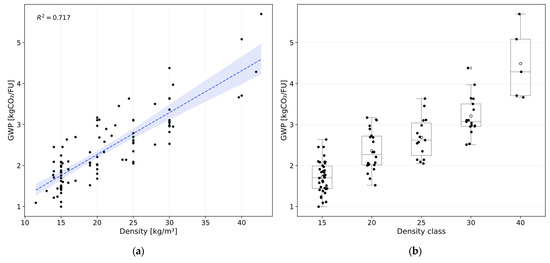
Figure 2.
(a) Regression monogram: GWP versus density for EPS panels; black points: data points without classification, dashed blue line: regression line, blue shadow: 95% confidence interval, R2: coefficient of determination; (b) Box plot of the GWP for different density classes; box plot elements: median (central line), quartiles (25th/75th percentiles), whiskers (1.5 × IQR), and mean value (white dot).
For stone wool panels, a consistent linear behavior was found between material density and GWP (R2 = 0.818, see Figure 3); Spearman’s rank correlation confirmed a highly significant positive monotonic relationship between these two variables (ρ = 0.82, p-value= 6 × 10−11). The effect of heteroscedasticity was more pronounced in comparison with the EPS case study (White’s test p-value: 0.068), and some non-linear effects were observed. The most significant grouping was achieved considering four density classes: low (11–39 kg/m3), medium (48–70 kg/m3), high (90–110 kg/m3), and very high (122–150 kg/m3) density (ANOVA p-value: 1.934 × 10−12, Kruskal–Wallis p-value: 1.645 × 10−6). A good grouping inside the low-density group was obtained when considering the energy mix (i.e., fossil and “green”): bootstrapped t-test p-value = 0.016. Nordic countries claimed benefits from utilizing renewable energy mixes, primarily sourced from hydroelectric and wind power generation, as well as high-temperature geothermal heat. Figure 3 shows that these products are mostly positioned in the lower interquartile range.
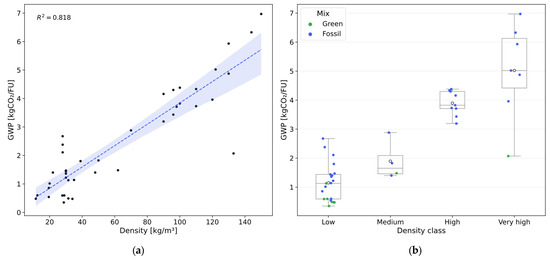
Figure 3.
(a) Regression monogram: GWP versus density for SW panels; black points: data points without classification; dashed blue line: regression line, blue shadow: 95% confidence interval, R2: coefficient of determination; (b) Box plot of the GWP for different density classes and fuel mixes; box plot elements: median (central line), quartiles (25th/75th percentiles), whiskers (1.5 × IQR), and mean value (white dot).
Considering a confidence level of 90%, the main statistics and margins of error reported in Table 9 and Table 10 were obtained. As can be noted, wider density class intervals tend to be associated with larger marginal errors or interquartile ranges.

Table 9.
Main descriptive statistics for the GWP (kg CO2/FU) of the EPS classes considered.

Table 10.
Main descriptive statistics for the GWP (kg CO2/FU) of the SW classes considered.
In conclusion, the principal structure of the variance in the embodied GWP of the two insulation panels considered can be attributed to the volumetric density of their constituent materials [22]. In the EPS case, the energy carrier has a secondary role in influencing the sample variance since the EPS expansion process is not highly energy intensive. A significant portion of the overall embodied energy and carbon, sometimes exceeding half of the total, is typically associated with raw materials. These materials are sourced internationally and produced using standardized processes, which are fossil fuels based.
From a regulatory perspective, the presence of aligned GWP values and production methodologies witnesses a low improvement potential in the climate change profile for these materials; the improvement is mainly linked to material use efficiency. To explore untapped decarbonization strategies, it would make sense to incentivize more varied production technologies, using more decarbonized energy mixes, particularly in regions like the Nordic countries with access to renewable energy resources.
3.2. Bricks
As regards bricks, the typology clusters basically overlap with the density clusters, with hollow bricks having a density range of 575–756 kg/m3 and full bricks being characterized by a density ranging from 1520 to 2120 kg/m3. Hollow bricks are characterized by lower embodied carbon due to a more efficient and shorter baking process [36]; depending on the size and moisture content, it takes around 8 to 12 h in a kiln for hollow bricks and around 24 to 36 h for full bricks, often with higher temperatures to ensure proper hardening. For the same reason, full bricks that have undergone a second firing process are expected to have a higher GWP content. On the other side, non-fired bricks, including adobe and reused bricks, demonstrated a markedly lower embodied carbon footprint. Studies in the literature confirmed that by eliminating or reducing the need for firing, the climate change impacts of brick production could be drastically reduced (e.g., adobe block [37], sun-dried clay bricks [38]).
A bootstrapping t-test was also conducted to assess the statistical representativeness of single-fired full and hollow bricks: the results confirmed a satisfactory level of representativeness (p-value = 0.0002). No other statistically significant difference among groups was obtained based on production country, PO, or LCA database.
When considering the role of the energy mix inside the categories already defined, a significant statistical grouping (bootstrapping t-test, p-value = 0.008) was found only for full bricks produced with ‘green’ energy mixes, defined as those utilizing over 50% renewable primary or secondary energy sources. The incorporation of this supplementary categorization led to the most robust statistical results (Kruskal–Wallis’s p-value= 9.53 × 10−7).
Figure 4a shows a box plot of the fossil GWP of hollow and full bricks. The bricks within the upper interquartile of the box plot are largely characterized by an energy mix during the baking process which is reliant on natural gas, gas combined with wood or coal. Conversely, the lower interquartile reveals a significant number of EPDs for bricks that claim to use biofuels, biogas, or a high share of renewable secondary fuels in their production process. The full brick outliers are second-fired, adobe, and reused bricks.
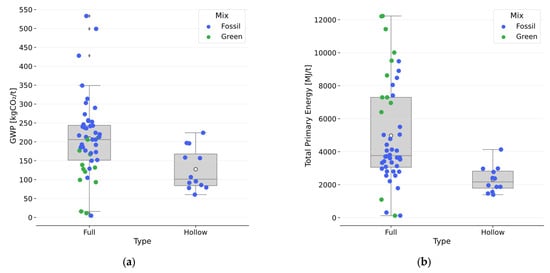
Figure 4.
Box plot of fossil GWP (a) and total primary energy (b) for hollow bricks vs. full bricks. Box plot elements: median (central line), quartiles (25th/75th percentiles), whiskers (1.5 × IQR), mean value (white dot), and outliers (gray diamonds).
Reverse figures were obtained when considering the embodied energy of bricks. As shown in Figure 4b, in fact, “green” bricks, whose mean renewable energy content was 85%, were characterized by a significantly higher embodied energy if compared with fossil-based bricks. This suggests a lower efficiency in the utilization of renewable resources compared to the use of fossil fuels, as confirmed by Anderson et al. [18].
Table 11 presents the main statistics found.

Table 11.
Main descriptive statistics for the brick categories obtained.
In summary, brick typology (full or hollow) and the fuel mix for baking/drying are the primary drivers of embodied GWP variability [36,39,40].
3.3. Concrete
Regarding ready-mixed concretes, statistical analysis revealed no significant groups based on the databases used in the LCA modeling (i.e., Ecoinvent or GaBi (Zurich, Switzerland)). No significant relationship was also found between the GWP and the density. A significant classification was obtained when grouping for the PO (F = 6.84, p-value = 0.0002) or the production country (F = 4.42, p-value = 0.0008). This substantial equivalence is connected to the high overlap between the POs and their geographic areas of operation, with only a few POs operating at the international level. Anderson and Moncaster [41] have already found a meaningful geographical distribution for the embodied GWP of concrete with countries like France, the UK, Norway, and Germany showing a relatively low impact. The observed outcome may be attributable to variations in concrete mix design across geographical regions. These variations are influenced by durability requirements, the incorporation of additives, climatic conditions, and exposure classes for concrete products. The use of locally sourced materials in ready-mixed concrete represents an additional twist for LCA modeling, as it demands local-scale characterization and introduces significant input variability.
The most significant partitioning found was based on compression resistance (F = 15.03, p-value = 3.57 × 10−15; Kruskal statistic = 60.27, p-value = 1.19 × 10−9). The compression resistance of concrete strongly depends on the cement content and on the mix design employed. Generally, more resistant concretes show a higher cement content, which is recognized as the most climate change impacting component of concrete [42,43].
Figure 5 shows the GWP of ready-mixed concrete against its characteristic cubic compression resistance at 28 days.
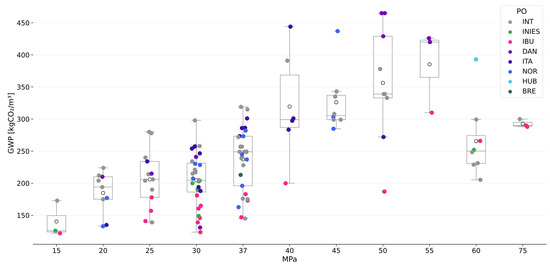
Figure 5.
Box plot of fossil GWP for ready-mixed concretes against their cubic compression resistance. Box plot elements: median (central line), quartiles (25th/75th percentiles), whiskers (1.5 × IQR), mean value (white dot), and outliers (gray diamonds).
3.4. Cement
Applying the statistical tests already described to cement data, no significant partition was found based on the production country, the PO, or the database used for the LCA. Significant aggregations were instead obtained considering the compression resistance class (F = 8.4, p-value = 0.0006; Kruskal statistic = 14.8, p-value = 0.0006), the cement category class (F = 25.1, p-value = 1.2 × 10−10; Kruskal statistic = 31.3, p-value = 7.2 × 10−7), and combining cement category and resistance classes (F = 19.6, p-value = 7.62 × 10−11; Kruskal statistic = 36.6, p-value = 7.2 × 10−7).
Since emissions at the kiln are preponderant, accounting for more than 80% of the total [44], the fuel mix used was expected to play a pivotal role in structuring the variance of the sample. However, considering two partitions based on the energy mix (alternative “green”, with PERT + RSF > 35%, and fossil predominant), no significant grouping was found. The lower heating value and moisture content of alternative fuels typically result in increased fuel consumption for the equivalent cement production, leading to increased emissions unless offset by improved process efficiencies [45].
Only when grouping inside the cement category groups, significant statistics were observed for CEM I (bootstrapped test = 4.89, p-value = 6.95 × 10−5). Thus, excluding the CEM I category where the clinker content is high and within a narrow range, the role of alternative fuels in structuring the embodied GWP of cement in EPDs remains quite weak in comparison with the clinker content. The high temperatures required for clinker production present a significant challenge to the integration of renewable energy sources and alternative fuels. Some EPDs indicate the use of alternative mixes, but their adoption is linked to a significant increase in the embodied energy of the material.
Figure 6 illustrates the GWP data, classified according to the most prominent categories identified. Following the methodology recommended by Lasvaux et al. [46], the average values obtained in this study were compared with Ecoinvent data and with the GWP values reported by the generic EPDs found [47]. A good alignment was achieved for the categories CEM I and CEM II, which are characterized by a relatively fixed and standardized mix design (see Table 12).
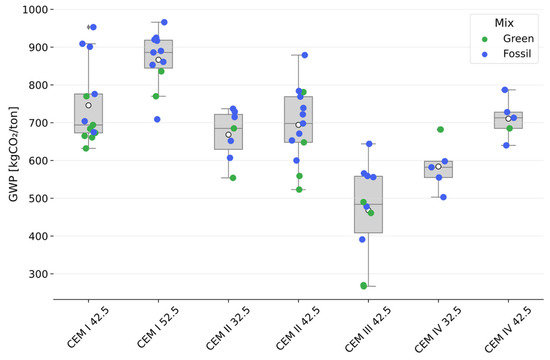
Figure 6.
Box plot of fossil GWP for the cement categories identified (“green” mix has PERT + RSF > 35% PET). Box plot elements: median (central line), quartiles (25th/75th percentiles), whiskers (1.5 × IQR), mean value (white dot), and outliers (gray diamonds).

Table 12.
Comparison of GWP average values of cement from different sources.
In conclusion, the embodied GWP of cement, as reported in EPDs, is primarily determined by its composition category and resistance class, both of which reflect the clinker content. As substantiated by existing research, the main strategy for mitigating the carbon footprint of cement production is the replacement of ordinary clinker-rich Portland cement with alternative materials, i.e., geo-polymers, blast furnace slag, calcium sulfate, coal fly ash, and natural pozzolanic materials [48,49,50].
3.5. Natural Stones
Concerning natural stones, statistically insignificant GWP groups were identified if partitioning for the production country, PO, LCA database, or producer. A weak significance was found when grouping green (100% renewable electricity purchase or declared emission factor <0.11 kgCO2/kWh) and non-green electricity mixes (bootstrapped t-test results: t = −2.76; p = 0.0377).
A statistically significant partitioning was found when grouping for the final product typology. Considering quarry blocks and all other final products, for instance, the bootstrapped t-test provided a p-value = 2.05 × 10−6. The average GWP for cut products is 136 kgCO2/t, significantly lower than the value of 255 kgCO2/t reported by the generic EPD found. Quarry blocks have an embodied GWP of 45 kgCO2/t, meaning that about two-thirds of the emissions are generated during the manufacturing phase. Considering final products, a significant partitioning was also obtained when grouping for the stone and final product typology (Kruskal–Wallis test results: test statistic H = 26.1, p-value = 0.002).
Based on the data collected, Figure 7a,b show the results obtained in the present study. The marble slabs are worthy of a specific focus due to the pronounced variability in their embodied GWP; generally, slabs undergoing multiple finishing processes using a residual electricity mix have the highest impact.
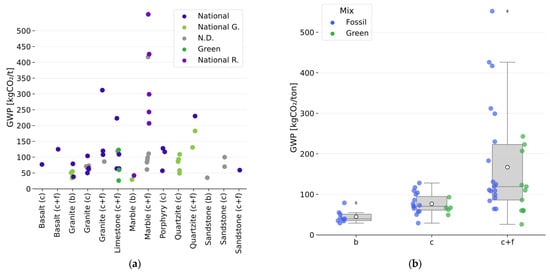
Figure 7.
(a) Strip plot for the fossil GWP of different natural stones products. Green electricity mixes are composed 100% of renewable sources while national green mixes are the ones with a carbon intensity lower than 0.1 kgCO2/kWh; national residual mixes represent uncertified electricity; N.D. stands for not declared. (b) Box plot of embodied GWP for b: quarry blocks, c: cut stones, c + f: cuts with surface finishing. A green production mix is characterized by a carbon intensity of less than 0.115 kgCO2/kWh, as defined by the ratio between embodied GWP and PET. Box plot elements: median (central line), quartiles (25th/75th percentiles), whiskers (1.5 × IQR), mean value (white dot), and outliers (gray diamonds).
The result highlights the importance of the stone manufacturing process which is different for each stone typology and related mechanical characteristics [51]. Beyond cutting, in fact, different additional working processes can be performed to enhance the surface finishing and esthetical appearance (polishing, honing, leathering, resin addition, flaming, bush-hammering, waterjet, and sand blasting) of stones. They contribute significantly to an increase in the variance of the embodied GWP of carved stone products (see Figure 7b). From a certification perspective, however, the absence of a standardized production process makes the comparison of stones’ environmental profiles quite complicated, since consolidated reference values are hard to determine considering the low number of certifications found and the variegated offer of products with different technical, finishing, and esthetical features. To determine more reliable benchmarks for each stonework, further certifications are required, which are currently difficult to find.
Generally, strong monotonic positive relationships were found between PENRT and GWT (ρ = 0.786190, p-value = 2.6 × 10−13), PET and GWP (ρ = 0.764052, p-value = 3 × 10−12) and PER and PENR (ρ = 0.829144, p-value = 9.1 × 10−16). High heteroscedasticity effects were observed.
The difficulty in defining reference values reduces the potential of EPDs to drive decarbonization efforts in the stone manufacturing sector. The electricity mix used in manufacturing, and its associated carbon intensity, emerges as a paramount factor in decarbonization efforts, thereby externalizing decarbonization leadership to the energy sector.
3.6. Structural Steel
A bootstrapping t-test was employed to ascertain whether a significant difference existed between the GWP of steel sections and rebars produced through EAF. The results were not statistically significant (p-value = 0.27). A Kruskal–Wallis test was then implemented considering three groups based only on the production method: BOF steel sections, EAF steel sections and rebars, and generic BOF/EAF steel section EPDs. The test confirmed the statistical representativeness of the groups created (p-value = 2.73 × 10−8), which represented the most robust segmentation found. Insignificant statistics were, in fact, obtained if aggregating for the producer, the PO, or the background life cycle database used. Moreover, it was not possible to evaluate the influence of the production country or the mechanical properties of the material on its embodied carbon; different manufacturers declared more than one production site with mechanical properties that have a wide range of variation (e.g., from S235 to S355 in most of the cases, or from S235 to S500 in two cases).
A significant grouping (bootstrapping t-test p-value = 0.015) was observed also when considering two groups based on the energy mix used in the EAF production process; “green” energy mixes were defined as those utilizing over 30% PERT and declaring the purchase of 100% green electricity.
Figure 8a displays a box plot of the GWP of the sample selected, categorized by the identified representative groups. When contrasted with the BOF process, EAF products showed better climate change performance and renewable integration (18.3% against 6.7% on average), attributable to the current characterization factors for electricity consumption in European countries. Moreover, as illustrated in Figure 8b, EAF steel showed approximately 39% of the embodied primary energy compared with BOF steel (10,375 MJ/t vs. 26,525 MJ/t). The carbon intensity of the EAF production process is therefore lower (see Figure 8b). Recycled content is also aligned with the production technologies, with BOF showing lower scarp shares (12–36%, avg. 21%) in comparison with EAF (76–100%, avg. 92%), as confirmed by Spooner et al. [52].
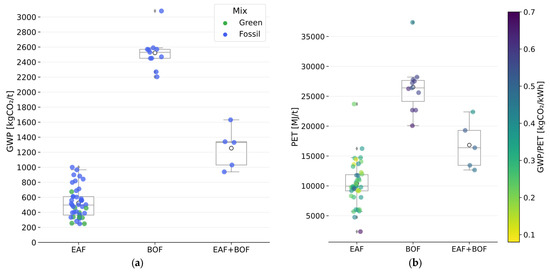
Figure 8.
(a) Box plot of fossil GWP for the steel categories obtained, considering energy mix (green production mix: PER/PET > 30% and GWP/PET < 0.20 kgCO2/kWh); (b) box plot of PET for the steel categories obtained considering manufacturing carbon intensity (GWP/PET—kgCO2/kWh). Box plot elements: median (central line), quartiles (25th/75th percentiles), whiskers (1.5 × IQR), mean value (white dot), and outliers (gray diamonds).
Table 13 summarizes the main descriptive statistics for the GWP of the steel product categories considered. Electricity proves effective for decarbonizing steel production, with EAF steel showing a lower embodied GWP, higher renewable content, and lower process carbon intensity (i.e., green process mixes are considered to be those with PER/PET > 30% and GWP/PET < 0.20 kgCO2/kWh).

Table 13.
Main descriptive statistics for the steel product categories considered.
The literature confirms that the production methodology and the energy vector used have a significant influence on the environmental profile of the structural steel industry, particularly in relation to its climate change impacts [53].
3.7. Windows
The application of the statistical methodology of the Kruskal–Wallis test confirmed that segmentations based on the frame material and on the number of panes characterizing the window system were significant. Grouping according to the number of glazed panes gave H = 10.27 with a p-value of 0.006, while grouping based on the frame material resulted in H = 9.63 with a p-value of 0.022; these results point to a statistically significant difference among groups using either classification method. The average results obtained are shown in Table 14 for GWP.

Table 14.
Results of EPDs of windows: average U-value and GWP as a function of m2.
Considering frames, the following interesting trend can be observed: generally, as shown in Figure 9, window types made of wood or a mix of wood and metals have a lower GWP compared with their metal peers [29,54]. Moreover, they have lower average thermal transmittance compared to the PVC or metal windows (see Table 14).
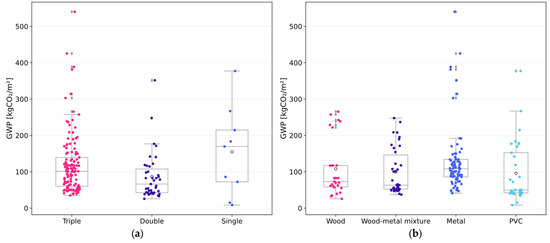
Figure 9.
Box plot of fossil GWP/m2 for different glazing types (a) and frame material (b). The values for each product category are colored differently. Box plot elements: median (central line), quartiles (25th/75th percentiles), whiskers (1.5 × IQR), mean value (white dot), and outliers (gray diamonds).
Concerning the number of panes, triple-glazed windows have GWP rather higher than double-glazed ones but a lower thermal transmittance (see Figure 9 and Table 14). This suggests that even though triple-glazed windows have a slightly higher embodied impact, they provide better thermal insulation and, consequently, may contribute to the reduction of overall energy consumption in a building over time.
The results obtained for single-glazed windows cannot be generalized because of their specific application; single-glazed windows are mainly applied as roof hatches or skylights in attics or lofts, opening and closing electrically. The reported GWP value of single-glazed windows also includes all the components necessary for such a movement mechanism, such as motors, electrical wiring, and controls, which are not included in any of the other analyzed window systems. This inflates the GWP associated with single-glazed windows.
In summary, the main variation parameters found for the embodied GWP of windows are the frame materials and the glazing configuration (single, double, or triple).
3.8. Wood
A Kruskal–Wallis test was performed using GWP fossil and GWP total (fossil + biogenic) data to assess the product categories already defined. The results showed a good statistical significance in both cases (with p-values, respectively, equal to 0.036 and 0.056). Although significant, the grouping by product categories is not justifiable in terms of drawing meaningful differences between the distributions of the four groups being analyzed due to the limited sample, especially when considering some product categories. Figure 10 presents box plots illustrating the overall GWP (FU = 1 kg) for wood products, including and excluding biogenic carbon. Table 15 shows the main statistics for the different groups.
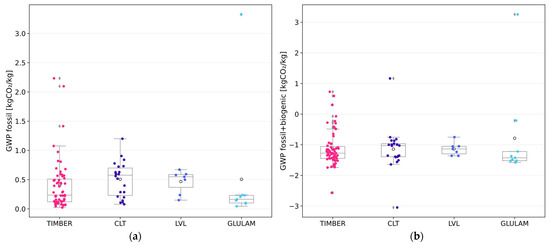
Figure 10.
Box plot of the embodied GWP of structural wood products (FU = 1 kg), excluding (a) and considering biogenic carbon (b). The values for each product category are colored differently. Box plot elements: median (central line), quartiles (25th/75th percentiles), whiskers (1.5 × IQR), mean value (white dot), and outliers (gray diamonds).

Table 15.
The mean of GWP and energy figures for the different wood product categories considered.
Considering energy uses as energy carriers (PERE, PENRE, RSF, and NRSF), a considerable increase in the PETE was detected as the share of renewable components increased (see Figure 11a). Applying clustering techniques, it was possible to define three distinct clusters: (1) low PETE (1.2–49 MJ/kg, with an average of 15 MJ/kg), (2) high PETE (64–102 MJ/kg) with a high renewable share (77–87%), and (3) high PETE (35–59 MJ/kg) with a high non-renewable share (80–89%). These clusters also represent a significant grouping when considering the fossil GWP (Kruskal–Wallis test: p-value = 0.0002), as depicted in Figure 11b. The clusters with high PETE are also associated with a higher embodied fossil GWP. This outcome is indeed influenced by the sample considered but highlights the importance of an efficient use of energy resources in reducing the embodied carbon of wooden products.
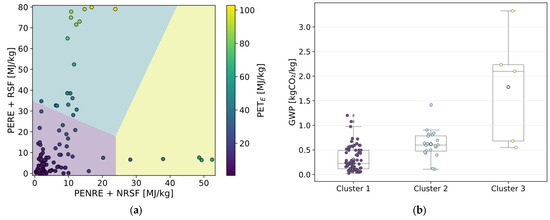
Figure 11.
(a) Relationship between non-renewable and renewable embodied energy, excluding energy inputs as raw materials, with resulting k-means clusters; (b) a box plot of the fossil GWP of structural wood products (FU = 1 kg), considering energy uses clusters obtained (Cluster 1—purple: low PETE, Cluster 2—azure: high PETE and high renewable share, Cluster 3—yellow: high PETE high non-renewable share). Box plot elements: median (central line), quartiles (25th/75th percentiles), whiskers (1.5 × IQR), mean value (white dot), and outliers (gray diamonds).
3.9. Photovoltaic Panels
Figure 12 gives the trend for PV panels embodied GWP impact as a function of peak power (WP). The GWP per square meter versus WP per square meter presents a correlation coefficient of r = 0.21, which happens to be a weak relationship between environmental impact and nominal power generation. Such findings indicate that the two parameters are not linked to one another, as expected [55,56,57]. A weak statistical significance was also found when grouping for the PO, but the low quantity of data makes the assessment unreliable.
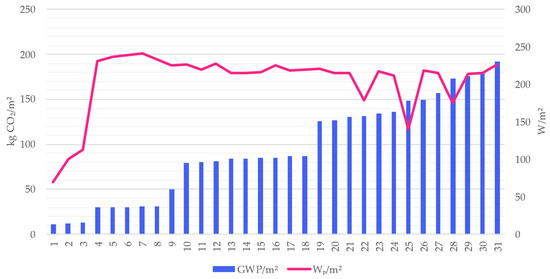
Figure 12.
Trend of GWP versus peak power (WP) as a function of a m2 of a photovoltaic panel.
The EPD scene for PV panels still appears not to be very consolidated. Given the low number of certifications found, the statistical analysis could not provide any meaningful result. Neither was it possible to analyze the effect of electricity mixes used in the manufacturing process, with related carbon intensities.
3.10. Heat Pumps
Given the limited availability of EPDs, the statistical analysis for heat pumps was also not applicable.
A critical analysis of the GWP data for the products shows a considerable difference in the GWP values. Heat pumps using R290 as a refrigerant have much lower GWP values compared to those containing R32. However, the embodied GWP is dependent on other variables besides the type of refrigerant, such as energy efficiency, life expectancy, and overall weight of materials used. The PET represents the total primary energy required for a product during its life cycle, including both renewable and non-renewable energy. Table 16 reports the main outcome found.

Table 16.
GWP and PET for the various heat pump models.
4. Discussion
After the individuation of the main variation parameters for embodied GWP and the classification of the construction products accordingly, the data retrieved from EPDs can be used to:
- Determine the reference mean or median values for different product categories;
- Define reference thresholds for lower and upper interquartile ranges representing over- and under-performant construction products from an environmental perspective;
- Individuate possible outliers (e.g., minimum or maximum thresholds and values that fall above or below box plot whiskers).
These values could prove valuable in several ways: by aiding building technicians in defining safety factors when utilizing EPDs during preliminary design phases [41,58], by motivating manufacturers to enhance the climate change performance of high-impact products, and by assisting EPD verifiers in identifying outliers.
The certification of construction products, however, assumed varying levels of relevance and played different roles across the different industrial sectors considered.
For internationalized and standardized product processes, in which the role played by fuel mixes was less important in determining the GWP, the climate change profile of construction products was mainly driven by the material’s inherent physical properties, chemical composition, or manufacturing techniques. For example, in the case of insulation panels, density, and thermal conductivity emerged as significant factors contributing to the variance in their embodied GWP, while the fuel mix was mainly dependent on fossil fuels, with low utilization of secondary materials and fuels. For structural steel, the EPDs promote the choice of EAF products due to their higher secondary material utilization, renewable energy use, and lower climate change impact. The alignment of production and evaluation methodologies results in narrowed confidence intervals for the “cradle to gate” GWP values, leading to more consolidated reference values (i.e., mean or median values, lower and upper interquartile bounds, outliers). For artisanal production processes, it was quite difficult to assess the impact of material properties and production techniques in shaping the embodied GWP of the material. The case study of natural stones is pertinent with large confidence intervals as the material surface treatment is further processed. A high segmentation of the products is necessary to establish reliable reference values, which in turn implies a large number of certifications. Conversely, the alignment of embodied GWP values and the standardization of the production processes attests to a low improvement potential in the climate change profile of these materials.
Local peculiarities or regional factors could represent interesting drivers making it possible to exploit the availability of renewable energy resources or recycled materials. Using local recycled materials and renewable energy sources increases GWP variability and enhances decarbonization potential. The efficient exploitation of these resources can enable the manufacturing of climate-competitive products. On the contrary, for high embodied energy and low embodied carbon materials (e.g., “green” bricks), the adoption of a consequential approach could be valuable to assess the effects of local energy resource utilization on the international scale. Indeed, the global relevance of climate change necessitates a significant international effort to align evaluation methodologies, production processes, and energy mixes on more sustainable pathways.
Finally, the PO and the background database used in the LCA did not play a very relevant role in determining embodied climate change impacts of all products considered, confirming a consolidated trend in Europe towards the alignment of evaluation methodologies, data harmonization, the verification of the results, and coordination [59].
5. Conclusions
The role of the industry is becoming increasingly pivotal as the building sector seeks to reduce operational energy consumption, thereby increasing the importance of embodied components. Within this framework, the EPDs can play an important role in driving the decarbonization of the construction industry, aligning production methods and energy mixes on more sustainable standardized pathways.
The results of the EPD analysis conducted showed that the definition of comparability and reference values (e.g., mean or median values which align with the ones provided by generic LCA databases) is enhanced in the case of standardized and internationalized production chains, a low dependence on local energy mixes, and a high number of certifications. For some construction materials, particularly for those produced through an artisanal production process, the definition of reference values is still challenging and requires an additional number of certifications and data. The definition of these benchmarks relies on the inherent universal thermo-physical properties of the materials or on specific manufacturing techniques. Conversely, the alignment of production methods and GWP values suggests limited potential for improvement in the embodied climate change profile of these materials.
The high dependence of a material’s climate change impact on specific energy mixes or local recycled materials gives the EPD results a higher variability, which translates into less consolidated product categories or reference values, but higher decarbonization potentials (e.g., lower interquartile values). For global impacts, such as climate change, a robust methodology is still lacking to assess the consequences for the international context of locally high renewable energy consumption.
A consolidated effort was instead observed on the reduction in the number of published PCRs, their mutual recognition by different POs, and the adoption of a specific background life cycle database or impact assessment methods for LCA modeling.
Author Contributions
Conceptualization, F.A. and G.G.; methodology, G.G. and F.A.; software, G.G. and D.M.G.; validation, F.A.; formal analysis, G.G. and D.M.G.; investigation, G.G. and D.M.G.; data curation, G.G. and D.M.G.; writing—original draft preparation, G.G. and D.M.G.; writing—review and editing, G.G.; supervision, F.A. All authors have read and agreed to the published version of the manuscript.
Funding
This study was possible thanks to the Project “Choisis—Characterisation of Innovative and Sustainable Insulating Solutions”, funded within the Italian National Recovery and Resilience Plan (PNRR), Mission 4—Education and Research—Measure M4C2—Investment 1.1 PRIN—Research programs of national interest—project code 2022372TM9, CUP F53D23001540006. The authors also gratefully acknowledge the support from the H2020 EU-funded project Climate Positive Circular Communities (grant agreement ID: 101036723), which aims at creating climate-positive circular communities in Europe and increasing the building renovation rate in the continent.
Data Availability Statement
The dataset is available on request from the authors.
Conflicts of Interest
The authors declare no conflicts of interest.
Abbreviations
The following abbreviations are used in this manuscript:
| BOF | Blast Oxygen Furnace |
| CLT | Cross-Laminated Timber |
| EAF | Electric Arc Furnace |
| EoL | End of Life |
| EPDs | Environmental Product Declarations |
| EPS | Expanded Polystyrene |
| FU | Functional Unit |
| Glulam | Glued Laminated Timber |
| GWP | Global Warming Potential (100 years) |
| LCA | Life Cycle Analysis or Assessment |
| LVL | Laminated Veneer Lumber |
| NRSF | Non-Renewable Secondary Fuels |
| PCR | Product Category Rules |
| PENRE | Total Non-Renewable Primary Energy, Energy Carriers |
| PENRM | Total Non-Renewable Primary Energy, Materials |
| PENRT | Total Non-Renewable Primary Energy |
| PERE | Total Renewable Primary Energy, Energy Carriers |
| PERM | Total Renewable Primary Energy, Materials |
| PERT | Total Renewable Primary Energy |
| PET | Total Primary Energy Requirement (PERT + PENRT + RSF + NRSF) |
| PETE | Total Primary Energy Requirement, Energy Carriers (PERE + PENRE + RSF + NRSF) |
| PO | Program Operator(s) |
| PV | Photovoltaic Panels |
| RSF | Renewable Secondary Fuels |
| SW | Stone Wool |
| WP | Peak Power |
References
- United Nations Environment Programme. Global Status Report for Buildings and Construction: Beyond Foundations - Mainstreaming Sustainable Solutions to Cut Emissions from the Buildings Sector. 2023. Available online: www.unep.org (accessed on 13 January 2025).
- United Nations Environment Programme. Global Status Report for Buildings and Construction: Towards a Zero-Emission, Efficient and Resilient Buildings and Construction Sector. 2022. Available online: www.unep.org (accessed on 13 January 2025).
- Economidou, M.; Todeschi, V.; Bertoldi, P.; D’Agostino, D.; Zangheri, P.; Castellazzi, L. Review of 50 years of EU Energy Efficiency Policies for Buildings. Energy Build. 2020, 225, 110322. [Google Scholar] [CrossRef]
- European Parliament and Council Directive 2010/31/EU of the European Parliament and of the Council of 19 May 2010 on the Energy Performance of Buildings. Available online: https://eur-lex.europa.eu/eli/dir/2010/31/oj/eng (accessed on 16 January 2025).
- Norouzi, M.; Haddad, A.N.; Jiménez, L.; Hoseinzadeh, S.; Boer, D. Carbon Footprint of Low-Energy Buildings in the United Kingdom: Effects of Mitigating Technological Pathways and Decarbonization Strategies. Sci. Total Environ. 2023, 882, 163490. [Google Scholar] [CrossRef] [PubMed]
- Asdrubali, F.; Ballarini, I.; Corrado, V.; Evangelisti, L.; Grazieschi, G.; Guattari, C. Energy and Environmental Payback Times for an NZEB Retrofit. Build. Environ. 2019, 147, 461–472. [Google Scholar] [CrossRef]
- Asdrubali, F.; Grazieschi, G. Life Cycle Assessment of Energy Efficient Buildings. Energy Rep. 2020, 6, 270–285. [Google Scholar] [CrossRef]
- Cusenza, M.A.; Guarino, F.; Longo, S.; Cellura, M. An Integrated Energy Simulation and Life Cycle Assessment to Measure the Operational and Embodied Energy of a Mediterranean Net Zero Energy Building. Energy Build. 2022, 254, 111558. [Google Scholar] [CrossRef]
- Asdrubali, F.; Baggio, P.; Prada, A.; Grazieschi, G.; Guattari, C. Dynamic Life Cycle Assessment Modelling of a NZEB Building. Energy 2020, 191, 116489. [Google Scholar] [CrossRef]
- Asdrubali, F.; Fronzetti Colladon, A.; Segneri, L.; Gandola, D.M. LCA and Energy Efficiency in Buildings: Mapping More than Twenty Years of Research. Energy Build. 2024, 321, 114684. [Google Scholar] [CrossRef]
- Röck, M.; Saade, M.R.M.; Balouktsi, M.; Rasmussen, F.N.; Birgisdottir, H.; Frischknecht, R.; Habert, G.; Lützkendorf, T.; Passer, A. Embodied GHG Emissions of Buildings—The Hidden Challenge for Effective Climate Change Mitigation. Appl. Energy 2020, 258, 114107. [Google Scholar] [CrossRef]
- Papadaki, D.; Nikolaou, D.A.; Assimakopoulos, M.N. Circular Environmental Impact of Recycled Building Materials and Residential Renewable Energy. Sustainability 2022, 14, 4039. [Google Scholar] [CrossRef]
- Trancone, G.; Policastro, G.; Spasiano, D.; Race, M.; Parrino, F.; Fratino, U.; Fabbricino, M.; Pirozzi, F. Treatment of Concrete Waste from Construction and Demolition Activities: Application of Organic Acids from Continuous Dark Fermentation in Moving Bed Biofilm Reactors. Chem. Eng. J. 2025, 505, 159536. [Google Scholar] [CrossRef]
- IPCC Climate Change 2021: The Physical Science Basis. Contribution of Working Group I to the Sixth Assessment Report of the Intergovernmental Panel on Climate Change; Cambridge University Press: Cambridge, UK; New York, NY, USA, 2021. [Google Scholar]
- Otero, M.S.; Garnica, T.; Montilla, S.; Conde, M.; Tenorio, J.A. Analysis of Sectoral Environmental Product Declarations as a Data Source for Life Cycle Assessment. Buildings 2023, 13, 3032. [Google Scholar] [CrossRef]
- 15804:2012+A1:2013; Sustainability of Construction Works—Environmental Product Declarations - Core Rules for the Product Category of Construction Products. European Committee for Standardization (CEN): Brussels, Belgium, 2013.
- EN 15804+A2:2019; Sustainability of Construction Works—Environmental Product Declarations - Core Rules for the Product Category of Construction Products. European Committee for Standardization (CEN): Brussels, Belgium, 2019.
- Anderson, J.; Moncaster, A. Embodied Carbon, Embodied Energy and Renewable Energy: A Review of Environmental Product Declarations. Proc. Inst. Civ. Eng. -Struct. Build. 2023, 176, 986–997. [Google Scholar] [CrossRef]
- ECO Platform AISBL ECO Platform. Available online: www.eco-platform.org (accessed on 15 January 2025).
- Blagoeva, D.; Pavel, C. Competitive Landscape of the EU’s Insulation Materials Industry for Energy-Efficient Buildings; Publications Office of the European Union: Luxembourg, 2018; ISBN 978-92-79-96383-4. [Google Scholar]
- Füchsl, S.; Rheude, F.; Röder, H. Life Cycle Assessment (LCA) of Thermal Insulation Materials: A Critical Review. Clean. Mater. 2022, 5, 100119. [Google Scholar] [CrossRef]
- Grazieschi, G.; Asdrubali, F.; Thomas, G. Embodied Energy and Carbon of Building Insulating Materials: A Critical Review. Clean. Environ. Syst. 2021, 2, 100032. [Google Scholar] [CrossRef]
- Hill, C.; Norton, A.; Dibdiakova, J. A Comparison of the Environmental Impacts of Different Categories of Insulation Materials. Energy Build. 2018, 162, 12–20. [Google Scholar] [CrossRef]
- Pargana, N.; Pinheiro, M.D.; Silvestre, J.D.; de Brito, J. Comparative Environmental Life Cycle Assessment of Thermal Insulation Materials of Buildings. Energy Build. 2014, 82, 466–481. [Google Scholar] [CrossRef]
- EN 1992-1-1:2004; Eurocode 2: Design of Concrete Structures—Part 1-1: General Rules and Rules for Buildings. European Committee for Standardization (CEN): Brussels, Belgium, 2004.
- EN 197-1; Cement—Part 1: Composition, Specifications and Conformity Criteria for Common Cements. European Committee for Standardization (CEN): Brussels, Belgium, 2011.
- World Steel Association Steel. Statistical Yearbook. 2024. Available online: https://worldsteel.org/ (accessed on 13 January 2025).
- Souviron, J.; van Moeseke, G.; Khan, A.Z. Analysing the Environmental Impact of Windows: A Review. Build. Environ. 2019, 161, 106268. [Google Scholar] [CrossRef]
- Asdrubali, F.; Roncone, M.; Grazieschi, G. Embodied Energy and Embodied GWP of Windows: A Critical Review. Energies 2021, 14, 3788. [Google Scholar] [CrossRef]
- Menzies, G.; Wherrett, J. Multiglazed Windows: Potential for Savings in Energy, Emissions and Cost. Build. Serv. Eng. Res. Technol. 2005, 26, 249–258. [Google Scholar] [CrossRef]
- Ramage, M.H.; Burridge, H.; Busse-Wicher, M.; Fereday, G.; Reynolds, T.; Shah, D.U.; Wu, G.; Yu, L.; Fleming, P.; Densley-Tingley, D.; et al. The Wood from the Trees: The Use of Timber in Construction. Renew. Sustain. Energy Rev. 2017, 68, 333–359. [Google Scholar] [CrossRef]
- D’Amico, B.; Pomponi, F.; Hart, J. Global Potential for Material Substitution in Building Construction: The Case of Cross Laminated Timber. J. Clean. Prod. 2021, 279, 123487. [Google Scholar] [CrossRef]
- Rasmussen, F.; Andersen, C.; Wittchen, A.; Hansen, R.; Birgisdóttir, H. Environmental Product Declarations of Structural Wood: A Review of Impacts and Potential Pitfalls for Practice. Buildings 2021, 11, 362. [Google Scholar] [CrossRef]
- Asdrubali, F.; Ferracuti, B.; Lombardi, L.; Guattari, C.; Evangelisti, L.; Grazieschi, G. A Review of Structural, Thermo-Physical, Acoustical, and Environmental Properties of Wooden Materials for Building Applications. Build. Environ. 2017, 114, 307–332. [Google Scholar] [CrossRef]
- EN 16449:2014; Wood and Wood-Based Products—Calculation of the Biogenic Carbon Content of Wood and Conversion to Carbon Dioxide. European Committee for Standardization (CEN): Brussels, Belgium, 2014.
- Asdrubali, F.; Grazieschi, G.; Roncone, M.; Thiebat, F.; Carbonaro, C. Sustainability of Building Materials: Embodied Energy and Embodied Carbon of Masonry. Energies 2023, 16, 1846. [Google Scholar] [CrossRef]
- Christoforou, E.; Kylili, A.; Fokaides, P.A.; Ioannou, I. Cradle to Site Life Cycle Assessment (LCA) of Adobe Bricks. J. Clean. Prod. 2016, 112, 443–452. [Google Scholar] [CrossRef]
- Dabaieh, M.; Heinonen, J.; El-Mahdy, D.; Hassan, D.M. A Comparative Study of Life Cycle Carbon Emissions and Embodied Energy between Sun-Dried Bricks and Fired Clay Bricks. J. Clean. Prod. 2020, 275, 122998. [Google Scholar] [CrossRef]
- Tibrewal, K.; Venkataraman, C.; Phuleria, H.; Joshi, V.; Maithel, S.; Damle, A.; Gupta, A.; Lokhande, P.; Rabha, S.; Saikia, B.K.; et al. Reconciliation of Energy Use Disparities in Brick Production in India. Nat. Sustain. 2023, 6, 1248–1257. [Google Scholar] [CrossRef]
- Soussi, N.; Kriaa, W.; Mhiri, H.; Bournot, P. Reduction of the Energy Consumption of a Tunnel Kiln by Optimization of the Recovered Air Mass Flow from the Cooling Zone to the Firing Zone. Appl. Therm. Eng. 2017, 124, 1382–1391. [Google Scholar] [CrossRef]
- Anderson, J.; Moncaster, A. Embodied Carbon of Concrete in Buildings, Part 1: Analysis of Published EPD. Build. Cities 2020, 1, 198–217. [Google Scholar] [CrossRef]
- Witte, A.; Garg, N. Quantifying the Global Warming Potential of Low Carbon Concrete Mixes: Comparison of Existing Life Cycle Analysis Tools. Case Stud. Constr. Mater. 2024, 20, e02832. [Google Scholar] [CrossRef]
- Barbhuiya, S.; Kanavaris, F.; Das, B.B.; Idrees, M. Decarbonising Cement and Concrete Production: Strategies, Challenges and Pathways for Sustainable Development. J. Build. Eng. 2024, 86, 108861. [Google Scholar] [CrossRef]
- Benhelal, E.; Zahedi, G.; Shamsaei, E.; Bahadori, A. Global Strategies and Potentials to Curb CO2 Emissions in Cement Industry. J. Clean. Prod. 2013, 51, 142–161. [Google Scholar] [CrossRef]
- Aranda Usón, A.; López-Sabirón, A.M.; Ferreira, G.; Llera Sastresa, E. Uses of Alternative Fuels and Raw Materials in the Cement Industry as Sustainable Waste Management Options. Renew. Sustain. Energy Rev. 2013, 23, 242–260. [Google Scholar] [CrossRef]
- Lasvaux, S.; Habert, G.; Peuportier, B.; Chevalier, J. Comparison of Generic and Product-Specific Life Cycle Assessment Databases: Application to Construction Materials Used in Building LCA Studies. Int. J. Life Cycle Assess. 2015, 20, 1473–1490. [Google Scholar] [CrossRef]
- CEMBUREAU The European Cement Association EPD for Cement. Available online: https://cembureau.eu/ (accessed on 14 January 2025).
- Amran, Y.H.M.; Alyousef, R.; Alabduljabbar, H.; El-Zeadani, M. Clean Production and Properties of Geopolymer Concrete; A Review. J. Clean. Prod. 2020, 251, 119679. [Google Scholar] [CrossRef]
- Verma, M.; Dev, N.; Rahman, I.; Nigam, M.; Ahmed, M.; Mallick, J. Geopolymer Concrete: A Material for Sustainable Development in Indian Construction Industries. Crystals 2022, 12, 514. [Google Scholar] [CrossRef]
- Scrivener, K.L.; John, V.M.; Gartner, E.M. Eco-Efficient Cements: Potential Economically Viable Solutions for a Low-CO2 Cement-Based Materials Industry. Cem. Concr. Res. 2018, 114, 2–26. [Google Scholar] [CrossRef]
- Bianco, I.; Blengini, G.A. Life Cycle Inventory of Technologies for Stone Quarrying, Cutting and Finishing: Contribution to Fill Data Gaps. J. Clean. Prod. 2019, 231, 419–427. [Google Scholar] [CrossRef]
- Spooner, S.; Davis, C.; Li, Z. Modelling the Cumulative Effect of Scrap Usage within a Circular UK Steel Industry—Residual Element Aggregation. Ironmak. Steelmak. 2020, 47, 1100–1113. [Google Scholar] [CrossRef]
- Nurdiawati, A.; Zaini, I.N.; Wei, W.; Gyllenram, R.; Yang, W.; Samuelsson, P. Towards Fossil-Free Steel: Life Cycle Assessment of Biosyngas-Based Direct Reduced Iron (DRI) Production Process. J. Clean. Prod. 2023, 393, 136262. [Google Scholar] [CrossRef]
- Citherlet, S.; Di Guglielmo, F.; Gay, J.-B. Window and Advanced Glazing Systems Life Cycle Assessment. Energy Build. 2000, 32, 225–234. [Google Scholar] [CrossRef]
- Akinyele, D.O.; Rayudu, R.K.; Nair, N.K.C. Life Cycle Impact Assessment of Photovoltaic Power Generation from Crystalline Silicon-Based Solar Modules in Nigeria. Renew. Energy 2017, 101, 537–549. [Google Scholar] [CrossRef]
- Galimshina, A.; Hollberg, A.; McCarty, J.; Waibel, C.; Schlueter, A. High-Resolution and Localized Parametric Embodied Impact Calculator of PV Systems. IOP Conf. Ser. Earth Environ. Sci. 2023, 1196, 012014. [Google Scholar] [CrossRef]
- Khan, A.A.; Reichel, C.; Molina, P.; Friedrich, L.; Subasi, D.M.; Neuhaus, H.; Nold, S. Global Warming Potential of Photovoltaics with State-of-the Art Silicon Solar Cells: Influence of Electricity Mix, Installation Location and Lifetime. Sol. Energy Mater. Sol. 2024, 269, 112724. [Google Scholar] [CrossRef]
- Palumbo, E.; Soust-Verdaguer, B.; Llatas, C.; Traverso, M. How to Obtain Accurate Environmental Impacts at Early Design Stages in BIM When Using Environmental Product Declaration. A Method to Support Decision-Making. Sustainability 2020, 12, 6927. [Google Scholar] [CrossRef]
- Passer, A.; Lasvaux, S.; Allacker, K.; De Lathauwer, D.; Spirinckx, C.; Wittstock, B.; Kellenberger, D.; Gschösser, F.; Wall, J.; Wallbaum, H. Environmental Product Declarations Entering the Building Sector: Critical Reflections Based on 5 to 10 Years Experience in Different European Countries. Int. J. Life Cycle Assess. 2015, 20, 1199–1212. [Google Scholar] [CrossRef]
Disclaimer/Publisher’s Note: The statements, opinions and data contained in all publications are solely those of the individual author(s) and contributor(s) and not of MDPI and/or the editor(s). MDPI and/or the editor(s) disclaim responsibility for any injury to people or property resulting from any ideas, methods, instructions or products referred to in the content. |
© 2025 by the authors. Licensee MDPI, Basel, Switzerland. This article is an open access article distributed under the terms and conditions of the Creative Commons Attribution (CC BY) license (https://creativecommons.org/licenses/by/4.0/).